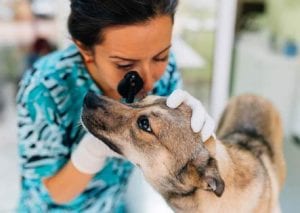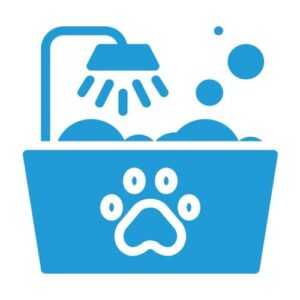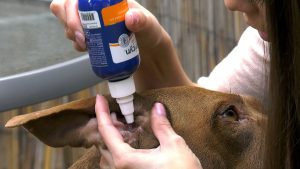
As the seasons change and foliage begins to bloom after the winter, it’s not just humans that suffer irritation from allergies – our furry friends get them too.
Many animals experience irritation from pollen and grass during seasonal changes and as these environmental allergens are often inhaled or eaten, they often cause a myriad of problems throughout the body—not just itchy eyes or a runny nose.
Common Symptoms of Seasonal Allergies in Pets
Many people miss the signs of seasonal allergies in dogs, cats or other household pets because they are looking for the same symptoms humans experience. Though some symptoms are shared between species, humans most commonly have respiratory issues during allergy season while animals are more likely to have skin problems.
 Keep an eye out for symptoms such as:
Keep an eye out for symptoms such as:
- Dry, itchy skin
- Excessive licking/scratching around the eyes, tail and ears
- Runny eyes or nose
- Paw chewing
- Swollen paws
- Ear infections
- Sneezing
- Snoring
Digestive issues such as vomiting and diarrhea may also occur due to allergies, but are a good indicator that the allergen is food-related.
Diagnosing Seasonal Allergies in Pets
 If you notice your pet experiencing any of the symptoms listed above, talk to your veterinarian about using skin or blood tests, or a special elimination diet, to determine the cause. Your veterinarian may also perform an intradermal skin test, similar to the one done on humans, to diagnose any allergies. Or, if your pet’s allergies are severe, they may prescribe medication or even shots.
If you notice your pet experiencing any of the symptoms listed above, talk to your veterinarian about using skin or blood tests, or a special elimination diet, to determine the cause. Your veterinarian may also perform an intradermal skin test, similar to the one done on humans, to diagnose any allergies. Or, if your pet’s allergies are severe, they may prescribe medication or even shots.
For more minor seasonal allergies, at-home treatments can help to ease your pet’s symptoms.
At-Home Treatments for Allergies in Pets
 Coat Care:
Coat Care:
One of the remedies for pet allergies is to give them frequent baths. Regular baths will help to soothe your pet’s itchy skin and wash away any irritants clinging to their coat. Use a shampoo that penetrates down to the skin and delivers moisturizing and nourishing ingredients, like Vetericyn FoamCare Shampoo. Itchy skin is especially common in dog seasonal allergies, so ensuring you have the right formula on hand for your dog’s coat type will be a big help during seasonal transitions.
 Home Cleaning:
Home Cleaning:
To keep allergens from building up in your home, vacuum and dust regularly. Wipe down your pets’ paws after they go outside to keep them from tracking allergens back indoors.
Use non-toxic cleaners instead of chemical ones as chemical cleaners are common irritants. You may also want to consider investing in an air purifier to remove any allergens from the air.
 Eyes and Ears:
Eyes and Ears:
If you notice your pet has itchy ears or eyes, use products specially formulated to flush away irritants from both areas. Not sure where to start? Check out our At-Home Pet Care blog for tutorials on cleaning your pet’s ears and eyes!
Good hygiene and a clean home can go a long way to easing your pet’s seasonal allergies. If you notice persistent symptoms, contact a veterinarian for further assistance and treatment. When it comes to at-home care for your pet, Vetericyn has the products you need to keep them feeling their best.


